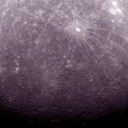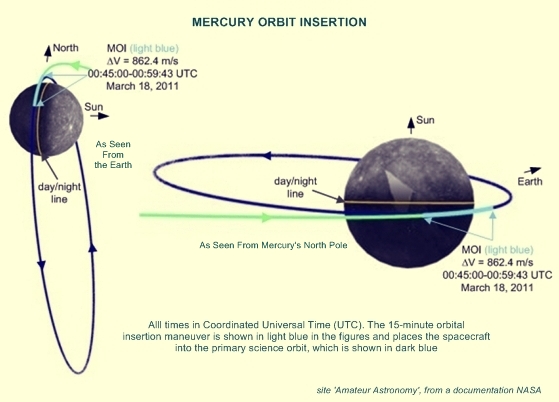
MESSENGER First Pictures of Mercury Released! NASA released the first pictures taken by MESSENGER at Mercury! MESSENGER took its first, 363 images of Mercury over a six-hour timespan, with that one captured by 5:20 am EDT on Mar. 29, 2011. That image is a historic one, because the first ever obtained from a spacecraft in orbit about the Solar System's innermost planet. Rayed crater is Debussy. More images keep downlinking from MESSENGER. click on picture below to a larger version
 | click to the first, historical picture of Mercury taken from orbit by MESSENGER on March 29th, 2011, the first picture ever obtained from a craft orbiting the innermost planet of the solar system. picture NASA/Johns Hopkins University Applied Physics Laboratory/Carnegie Institution of Washington |
MESSENGER achieved into its definitive, working orbit about Mercury on March 17th, 2011 by 9 a.m. EDT (March 18th, 2011 GMT), through a 15-minute insertion maneuver, making it the first ever craft to orbit around the swift planet! How did that happen, with a description of a planetary mission orbit insertion maneuver? (that description from a anticipated description in a press kit NASA, hence with verbs in the future mode)
Just over 33 hours before the main Mercury orbit insertion event, two antennas from the Deep Space Network -one main antenna and one backup- will begin to track the MESSENGER spacecraft continuously and nearly thirty-one hours later, at 6:30 p.m. EDT on March 17, 2011, the number of antennas tracking MESSENGER will increase to five, four of these are arrayed together in order to enhance the signal coming from the spacecraft, and a fifth will be used for backup. Antennas from each of the three DSN ground stations began continuous monitoring since March 7. About two and a half hours later, at 8:00 p.m. EDT, the solar arrays, telecommunications, attitude control, and autonomy systems will all be configured for the main thruster firing (known as a 'burn'), and the spacecraft will be turned into the correct orientation for MESSENGER’s Mercury orbit insertion maneuver
 | MESSENGER Mission Mercury Orbit Insertion Diagrams. courtesy site 'Amateur Astronomy' from a documentation NASA |
The main thruster burn will begin firing very close to the direction of flight at 8:45 p.m. and will continue for 14 minutes as other thrusters will take relay for 1 minute more, until 9:00 p.m. Like any orbital insertion maneuver, the burn is aiming to sufficiently brake MESSENGER speed to get it captured into Mercury's orbit. The braking will be of just over 0.53 miles per second (0.86 km/s). You will note that the insertion occurs interestingly from above the north pole of Mercury! After the thruster has finished firing, the spacecraft will be turned toward Earth and reconfigured for normal post-maneuver operations. Data will be collected by Deep Space Network antennas, allowing the MESSENGER team to confirm the insertion by about one hour later. Approximately one and a half hours after the maneuver is complete, the DSN coverage will be stepped back to two stations. At 2:47 a.m. EDT on March 18, the spacecraft will begin its first full orbit around Mercury (as measured from the highest point in the orbit, or perigee). About 10 hours later, the Deep Space Network coverage will be further reduced to continuous coverage with only one station. The MESSENGER spacecraft will continue to orbit Mercury once every twelve hours for the duration of its primary mission. The first two weeks from orbit insertion will be focused on ensuring that the spacecraft systems are all working well in the harsh thermal environment of orbit; this interval is known as the orbital commissioning phase. Starting on March 23 the instruments will be turned on and checked out, and on April 4 the science phase of the mission will begin and the first orbital science data from Mercury will be returned. Once on science orbit, small forces, such as solar gravity —the gravitational attraction of the Sun— slowly change the spacecraft’s orbit leading to a possible increase the spacecraft’s minimum altitude, orbit inclination, and latitude of the surface point below MESSENGER’s minimum altitude. To keep the orbit straight, propulsive maneuvers must occur at least once every Mercury year, or 88 Earth days
| Ground Receipt Time | Spacecraft Time | Event | |||
| (EDT) | Coordinated Universal Time (UTC) (DOY-hh:mm) | Time Relative to Burn Start (hh:mm) | |||
| (times given in the first column are ground receipt times, which are approximately 9 minutes after a maneuver is executed on the spacecraft. They are adjusted for one-way light time, which gradually decreases through the reporting period. Events without specific execution times are initiated by direct commands from the ground) | |||||
| Tuesday March 15 | 8:54 p.m. | 75-00:45 | 48:00 | Start initial pre-burn propulsion system configuration | |
| Wednesday March 16 | 11:40 a.m. | 75-15:31 | 33:14 | Start critical Deep Space Network coverage (two stations, one primary and one backup) | |
| 8:54 p.m. | 76-00:45 | 24:00 | Spacecraft commanded to pre-critical burn configuration | ||
| Thursday March 17 | 5:00 p.m. | 76-20:51 | 03:54 | Start configuration for DSN burn coverage (four stations arrayed together) | |
| 6:30 p.m. | 76-22:21 | 02:24 | Finish configuration for DSN burn coverage (backup 70-m antenna) | ||
| 7:45 p.m. | 76-23:37 | 01:09 | Start final pre-burn propulsion system configuration | ||
| 8:09 p.m. | 77-00:00 | 00:45 | Start RF configuration for burn execution | ||
| 8:21 p.m. | 77-00:12 | 00:33 | Complete RF configuration for burn execution | ||
| 8:24 p.m. | 77-00:15 | 00:30 | Turn spacecraft to burn attitude and configure attitude control for burn execution | ||
| 8:34 p.m. | 77-00:25 | 00:20 | Configure solar arrays for burn execution | ||
| 8:49 p.m. | 77-00:40 | 00:05 | Configure spacecraft fault protection for burn execution | ||
| 8:54 p.m. | 77-00:45 | 00:00 | Mercury orbit insertion (MOI) engine ignition | ||
| 9:09 p.m. | 77-01:00 | 00:15 | Engine shutdown | ||
| 9:21 p.m. | 77-01:12 | 00:27 | Turn spacecraft to Earth and acquire post-maneuver data | ||
| 9:32 p.m. | 77-01:23 | 00:38 | Re-configure spacecraft systems for normal post-maneuver operations | ||
| 10:25 p.m. | 77-02:16 | 01:31 | End DSN burn coverage (back to critical coverage with 2 stations) | ||
| Friday March 18 | 2:56 a.m. | 77-06:47 | 06:02 | First orbital apoapse passage (start orbit #1) | |
| 12:40 p.m. | 77-16:31 | 15:46 | End DSN critical coverage (back to 1 station continuous coverage) | ||
| 2:57 p.m. | 77-18:48 | 18:03 | Second orbital apoapse passage (start orbit #2) | ||
| Monday March 21 | 12:56 p.m. | 80-16:48 | Orbital commissioning period begins (spacecraft checkout) | ||
| Tuesday March 22 | Start Gamma-Ray Spectrometer (GRS) cooler | ||||
| Wednesday March 23 | Turn on all instruments and configure for operations (except imagers) | ||||
| Monday March 28 | 3:51 p.m. | 087-19:45 | Continue orbital commissioning period (Instrument checkout — imagers turned on) | ||
| Monday April 4 | 4:20 p.m. | 094-20:15 | Mercury science observations begin | ||